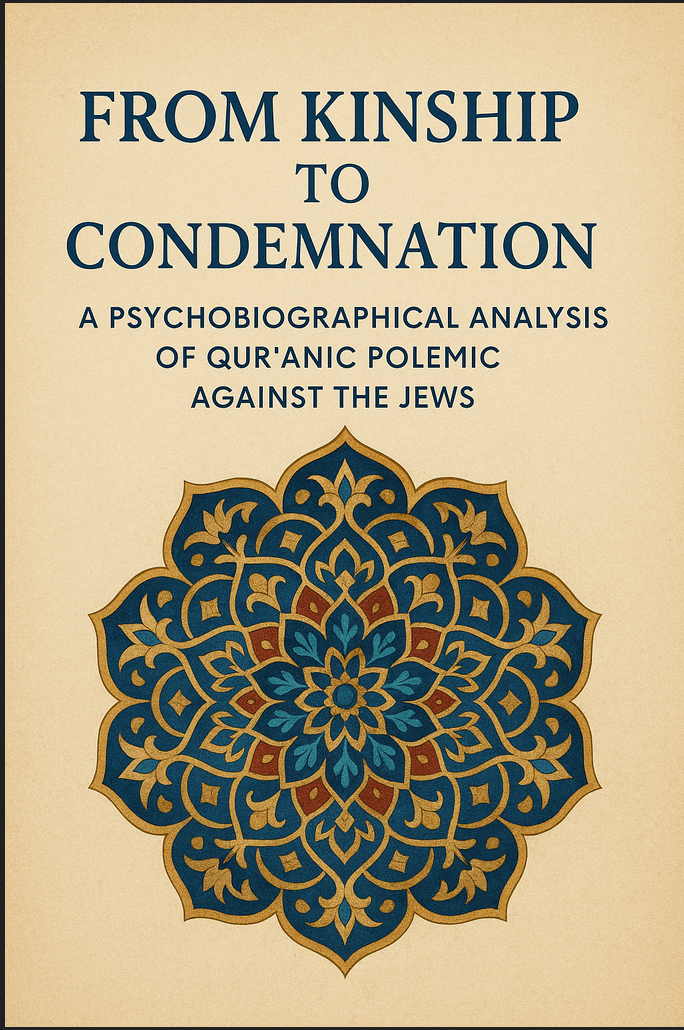

By Dr. Tim Orr
Disclaimer: This is a lengthy scholarly abstract of a paper I am currently completing, which I will present at the ASMEA Conference in Washington, DC, later this year. I will publish the full paper next month on academic.edu
What happened to the Ahl al-Kitāb, the “People of the Book”? How did they go from being respected monotheistic kin to targets of harsh critique in the Qur’an? This paper looks at the emotional undercurrents behind that shift, especially in how the Qur’an speaks about Jews. It traces how early gestures of inclusion gave way to sharper lines of condemnation and asks what that tells us about the prophet’s own experience along the way. This study returns to the Qur’an not only as a sacred text but as a rhetorical window into the Prophet Muhammad’s inner world. This shift brings us back to a central question in this study: how did Jews, once honored in the Qur’an, end up as its primary target of criticism, while Christians, though theologically corrected, rarely face the same emotional force?
To explore this, the paper turns to psychobiography, utilizing Rejection Sensitivity Theory and narrative identity models to examine how Muhammad’s personal story may have influenced the way revelation came through him (Downey & Feldman, 1996; Kaplan, 2021). His early losses, especially being orphaned, and the rejection he faced later in life, may have left emotional traces in the text itself—not just in what it says, but in how it feels. Rather than reducing the Qur’an to a psychological artifact, I apply a Qur'an-centric methodology—one that not only emphasizes internal textual analysis but also distinguishes itself from existing literary studies by incorporating psychological dynamics into the rhetorical development of revelation (Neuwirth, 2019). This approach departs from traditional thematic or stylistic readings by foregrounding how emotional experience may have influenced the structure and tone of sacred discourse, particularly in the context of interreligious polemics. That emphasizes internal analysis of the Qur'anic text itself, tracing its structural, rhetorical, and thematic development without relying on later Islamic historiography. I treat it as a historically grounded text that integrates divine speech with human experience. Using a Qur’an-centric methodology, I set aside later sīra and hadith literature, which often retroject theological agendas, in favor of analyzing the internal structure and rhetorical progression of the Qur’anic corpus itself. Scholars such as Patricia Crone, Fred Donner, and Angelika Neuwirth have taken this approach, examining how the Qur’an evolved as a literary text and how profoundly it was influenced by the religious and social context of Late Antiquity (Crone & Cook, 1977; Donner, 2010; Neuwirth, 2019).
Building on that, this paper suggests that in the early Medinan period, Muhammad wasn’t just hoping for theological alignment from the Jews; he was looking for something more personal. He expected recognition. And beneath that expectation was a more profound yearning: the need to be affirmed by those he thought would understand his mission. The Jewish tribes of Medina were not remote communities; they were local, relational, and scripturally aware. Their rejection, therefore, was not abstract—it was intimate and personal. The Qur’an initially reaches out with shared stories and praise (e.g., Q 2:47). Still, following their refusal, its tone sharpens (e.g., Q 5:64, Q 9:30). This progression mirrors what Rejection Sensitivity Theory (RST) describes—a framework increasingly used in modern psychobiographical analyses of religious figures such as Moses and Jesus (Kaplan, 2021). In contrast, Christian communities, often more distant and less involved in direct conflict, receive theological critique (e.g., Q 5:73) but rarely the same emotive denunciation.
Affective neuroscience supports this reading. Verses such as “Perhaps you will kill yourself with grief over them” (Q 18:6) and “Your breast is straitened by what they say” (Q 15:97) point to psychosomatic responses to rejection. Some of these interpretations draw strength from affective neuroscience—especially the work of Jaak Panksepp, who studied the brain’s emotional systems, and Eddie Harmon-Jones, who explored how distress shows up in neural activity (Panksepp, 1998; Harmon-Jones & Harmon-Jones, 2013). Their research helps ground emotional interpretations of the Qur’an that traditional tafsīr often overlooks. Take verses like Q 18:6 or Q 15:97, “Your breast is straitened by what they say.” These aren’t just poetic flourishes. They suggest real psychosomatic responses to rejection, which become more legible when seen through the lens of emotional development.
Scholars like Raymond Farrin and Nicolai Sinai have shown that the Qur’an’s literary design—its ring structures and mirrored patterns—isn’t just about style or symmetry (Farrin, 2014; Sinai, 2017). These features often provide psychological closure, calming the emotional tension stirred up earlier in the text. In that sense, the Qur’an offers more than doctrine; it tells a story that soothes the soul. The Prophet’s sorrow, his longing for recognition, and even his grief aren’t side notes—they’re built into the revelation itself. Surahs like al-Ḍuhā and al-Inshirāḥ speak directly to that ache, offering comfort in the face of rejection. Erik Erikson once noted that early emotional instability can shape how people respond to later threats, and something like that may be happening here (Erikson, 1959). When Muhammad’s tone toward the Jews in Medina grows sharper, it’s not just politics or polemic. It feels more like wounded hope hardening into theology.
The paper also builds on the work of scholars such as Fred Donner and Gabriel Said Reynolds, who situate early Islam as a “Believers’ Movement” with an initial inclusivity (Donner, 2010; Reynolds, 2010). I don’t think the move toward exclusivism was just about politics; it also stemmed from something more personal and emotional. And Islam isn’t the only place we see this. Early Christianity, for example, eventually broke away from Judaism like this. After the exile, Jewish communities also drew more precise theological boundaries as they navigated both internal struggles and external pressures. What ties these moments together isn’t just belief, it’s the emotional weight behind it: the urgency to protect identity, to respond to rejection, and to survive in the face of conflict. Political flashpoints, such as the reported treaty breaches by the Banu Qaynuqa and Banu Qurayza, heightened the tension. Theological disagreement wasn’t just a matter of belief anymore; it became a political issue. But something else was going on, too. These events hit an emotional chord. What started as rejection grew into something heavier, a firmer sense of identity, shaped not just by theology, but by grief, pressure, and conflict.
This kind of reading doesn’t just speak to Muhammad’s story. It opens up questions about how we think about the early formation of Islam and about how we understand the long, complicated relationship between Jews and Muslims. It builds upon Bernard Lewis’s insight about the historical break between Jews and Muslims, but adds something he didn’t explore—how the Prophet’s changing tone might reflect a deeper psychological struggle (Lewis, 1984). Whereas Lewis emphasized the political and theological codification of animosity, this paper adds a new layer: that the emotional experience of rejection may have contributed to shaping the rhetorical transformation in the Qur’anic discourse. This paper builds on Lewis’s work by bringing emotional history and a psychobiographical lens into the conversation. It doesn’t try to pathologize the Prophet, but it does ask whether the emotional life of a messenger might leave traces in the text he delivers. Instead of setting aside the Prophet’s humanity, it suggests that divine speech in Islam—like in other faiths—often meets the messenger in his grief. In that convergence lies both the power of revelation and its emotional depth. This paper argues that the Qur’an’s shifting tone toward the Jewish people wasn’t just about doctrine. It also reflected the prophet’s struggle, trying to stay faithful to his sense of divine calling while dealing with the pain of rejection. That tension comes through in the text and still lingers in how Muslims and Jews relate today.
References
Crone, P., & Cook, M. (1977). Hagarism: The making of the Islamic world. Cambridge University Press.
Donner, F. M. (1981). The early Islamic conquests. Princeton University Press.
Donner, F. M. (2010). Muhammad and the believers: At the origins of Islam. Harvard University Press.
Downey, G., & Feldman, S. I. (1996). Implications of rejection sensitivity for intimate relationships. Journal of Personality and Social Psychology, 70(6), 1327–1343. https://doi.org/10.1037/0022-3514.70.6.1327
Erikson, E. H. (1959). Identity and the life cycle. International Universities Press.
Farrin, R. (2014). Structure and Qur’anic interpretation: A study of symmetry and coherence in Islam’s holy text. White Cloud Press.
Harmon-Jones, E., & Harmon-Jones, C. (Eds.). (2013). Social neuroscience of motivation. Psychology Press.
Kaplan, G. (2021). Religion and rejection: Explorations in rejection sensitivity. Springer.
Lewis, B. (1984). The Jews of Islam. Princeton University Press.
Neuwirth, A. (2019). The Qur’an and late antiquity: A shared heritage. Oxford University Press.
Panksepp, J. (1998). Affective neuroscience: The foundations of human and animal emotions. Oxford University Press.
Reynolds, G. S. (2010). The Qur’an and its biblical subtext. Routledge.
Sinai, N. (2017). The Qur’an: A historical-critical introduction. Edinburgh University Press.
Who is Dr. Tim Orr?
Tim serves full-time with Crescent Project as the assistant director of the internship program and area coordinator, where he is also deeply involved in outreach across the UK. A scholar of Islam, Evangelical minister, conference speaker, and interfaith consultant, Tim brings over 30 years of experience in cross-cultural ministry. He holds six academic degrees, including a Doctor of Ministry from Liberty University and a Master’s in Islamic Studies from the Islamic College in London.
In addition to his ministry work, Tim is a research associate with the Congregations and Polarization Project at the Center for the Study of Religion and American Culture at Indiana University Indianapolis. His research interests include Islamic antisemitism, American Evangelicalism, and Islamic feminism. He has spoken at leading universities and mosques throughout the UK, including Oxford University, Imperial College London, and the University of Tehran. He has published in peer-reviewed Islamic academic journals. Tim is also the author of four books.
